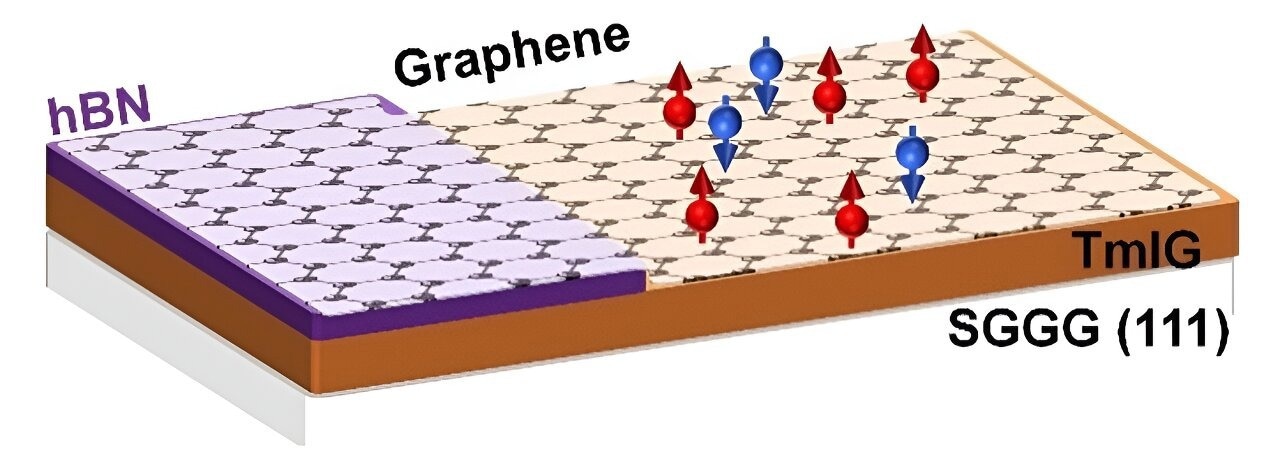In an advancement for the field of two-dimensional spintronics, physicists at the National University of Singapore (NUS) have developed a new concept for inducing and quantifying spin splitting in two-dimensional materials. This innovation, notably applied to graphene, promises to revolutionize low-power electronic devices.
 Figure showing the diffusion of spin-polarized electrons within a graphene layer placed on top of a ferrimagnetic insulating oxide Tm3Fe5O12 (TmIG). The strong exchange interaction between the graphene and TmIG results in a significant spin splitting of the graphene band structure. This spin splitting, in turn, results in a substantial difference in the density of charge carriers with spin orientations labeled as "spin up" (↑) and "spin down" (↓). This difference in carrier density gives rise to the generation of a spin-polarized current. Image Credit: Advanced Materials
Figure showing the diffusion of spin-polarized electrons within a graphene layer placed on top of a ferrimagnetic insulating oxide Tm3Fe5O12 (TmIG). The strong exchange interaction between the graphene and TmIG results in a significant spin splitting of the graphene band structure. This spin splitting, in turn, results in a substantial difference in the density of charge carriers with spin orientations labeled as "spin up" (↑) and "spin down" (↓). This difference in carrier density gives rise to the generation of a spin-polarized current. Image Credit: Advanced Materials
Modern electronics, particularly those in personal computing and smartphone technology, face a critical challenge in the form of Joule heating. This phenomenon, where electrical current generates thermal energy, thus raising a device's temperature, has prompted the exploration of alternative solutions. Spintronics, a field that utilizes the spin of electrons instead of their charge in logic circuits, emerges as a promising candidate. This approach is expected to offer significant advantages in terms of power consumption and operational speed by minimizing or eliminating Joule heating.
Graphene, with its extensive spin diffusion length and enduring spin lifetime even at ambient conditions, is an ideal candidate for spintronic applications. However, the material's inherent non-spin-polarized nature and the challenges in measuring spin-splitting energy have been stumbling blocks. Addressing these issues, Professor Ariando and his team from the NUS Department of Physics have devised an innovative method to directly quantify spin-splitting energy in graphene.
Utilizing the Landau fan shift, a phenomenon that indicates the shift of intercept in oscillation frequency plots due to energy level splitting in a magnetic field, the team managed to measure the spin-splitting energy in magnetic graphene. This technique, combined with field cooling—a method for tuning spin-splitting energy—has led to significant tunability and a high degree of spin polarization in graphene.
This research, detailed in Advanced Materials, included a series of experiments where the team developed a magnetic graphene structure. By stacking monolayer graphene atop a magnetic insulating oxide (Tm3Fe5O12), they successfully quantified a spin-splitting energy value of 132 meV. Further, the use of X-ray magnetic circular dichroism at the Singapore Synchrotron Light Source shed light on the origins of spin polarization.
Our work solves the long-standing controversy in 2D spintronics, by developing a concept that uses the Landau fan shift to directly quantify the spin splitting in magnetic materials.
Dr. Junxiong Hu, Study Lead Author, Department of Physics, National University of Singapore
Collaborating with Professor Zhenhua Qiao's theoretical team from the University of Science and Technology of China, they validated their experimental findings with theoretical calculations and advanced machine learning techniques. These collaborations enhanced the understanding of spin-splitting energy tunability.
Our work develops a robust and unique route to generate, detect and manipulate the spin of electrons in atomically thin materials. It also demonstrates a practical use of artificial intelligence in materials science. With the rapid development and significant interest in the field of 2D magnets and stacking-induced magnetism in atomically thin van der Waals heterostructures, we believe our results can be extended to various other 2D magnetic systems.
Ariando Ariando, Study Corresponding Author and Deputy Head, Research and Graduate Studies, National University of Singapore
Looking forward, the research team aims to expand upon this foundational study by exploring spin current manipulation at room temperature, with the ultimate goal of developing 2D spin-logic circuits and magnetic memory/sensory devices. This research lays the groundwork for a new generation of low-power, ultrafast electronic devices, potentially transforming the landscape of electronic technology.
The researchers worked with a theoretical group headed by Professor Zhenhua Qiao from the University of Science and Technology of China to compute the spin-splitting energy using first-principles calculations to corroborate their experimental results.
The obtained theoretical outcomes aligned with their experimental data. Additionally, they fit their experimental data using machine learning based on a phenomenological model, which offers a more comprehensive comprehension of the tunability of spin-splitting energy through field cooling.
The research team intends to investigate room-temperature spin current manipulation, building on this proof-of-concept investigation. Their objective is to use their discoveries to create magnetic memory/sensory devices and 2D spin-logic circuitry.
A new age of low power consumption and ultrafast speed electronics can be achieved using all-electric spin field-effect transistors, which are based on the ability to efficiently tune the spin polarization of current.
Journal Reference:
Hu, J., et al. (2023) Tunable Spin-Polarized States in Graphene on a Ferrimagnetic Oxide Insulator. Advanced Materials. doi:10.1002/adma.202305763
Source: https://nus.edu.sg/